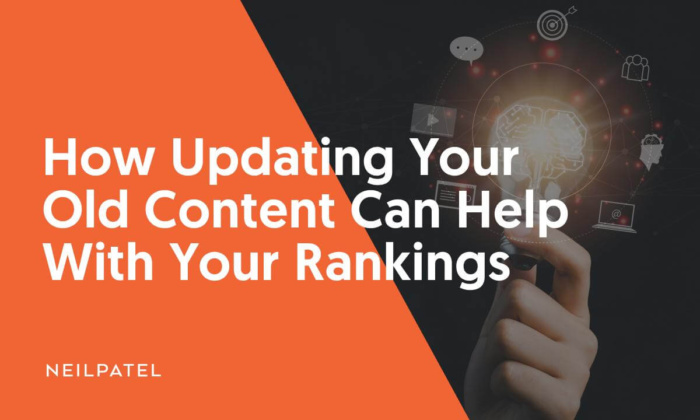
There’s a strategy that will help you skyrocket those rankings without a lot of extra work.
Yes, you could keep writing and producing more content. But this is complicated and it takes lots of time.
Instead, you can update old content. It takes less work and delivers faster results which can only be beneficial for your overall content marketing strategy.
To increase the effectiveness of your SEO efforts and boost your search engine traffic, you can just update your old content and give yourself an improved freshness score.
When you tell Google your content is new, you’ll get a spike in traffic that will make the tiny amount of work required well worth it.
In fact, this has been known since Google’s announcement in 2011, and their reiteration of this as a ranking factor in 2020.
In this article, we’ll discuss how you know you need to refresh content. We’ll also share relevant data we’ve collected on refreshing content from our very own blog, as well as 14 benefits you may receive as a result of updating your old content.
Let’s get started.
How Do You Know A Piece of Content Needs To Be Refreshed?
We tend to think that the work we publish is always our best work. That may be true at the time of publishing, but things change over time.
Just consider SEO.
How much has SEO changed in the last 10 years? Five years? One year?
The answer is, a lot.
The same can be said for so many other topics and niches.
So how do you know a piece of content needs to be refreshed?
There are a few telltale signs that your content is in need of an update, including:
- New information becomes available. Be sure to regularly (i.e., every six months or so) update articles with new studies, new research, and the most up-to-date backlinks. Topics can rapidly evolve over time.
- When it becomes irrelevant. If your post was highly specific (e.g., X Socially Distanced Vacation Spots for the COVID-Conscious Traveler), it might need to be completely revamped or even retired.
- When it begins to underperform. If your post has been published for a while, you may start to notice that impressions and clicks drop off. You may also notice you’re ranking for fewer keywords than before.
- When it becomes “old.” The older your post gets, the more out-of-date your content and backlinks become. Be sure to evaluate your content at least once per year to avoid your content becoming too stale for your readership.
Of course, you can also update your content whenever you want. You don’t need a reason to update your content, but if it’s currently performing well, then keep an eye on the changes you make and their impact on your metrics.
What Our Data Shows Us About Refreshing Content
Updating your old content is important, but exactly what benefits might you see from refreshing your content regularly?
Take a look at three of our own updates of old content and how they performed.
Refresh: What is A Shadow Ban? (and How to Fix It)
What We Refreshed
The team refreshed the meta data to be more aligned with user intent, updated the content to be up to date with the terminology (it was previously written about ghostbanning which is now coined shadowbanning), and updated the keyword targets.
The content refresh was published on August 7th, 2022.
How the Refresh Impacted Our Metrics

The above chart shows 16 months of performance data for this particular blog post. When we refreshed this, there was an instant lift in performance.
Let’s break this down.
On August 6th, 2022, one day before the content was updated, the blog had 134 clicks. On August 8th, 2022, one day after the content was updated, the blog had 245 clicks.
So what about longer-term performance metrics?
When we look at the data period-over-period (PoP), we see a 96% boost in clicks.
Pre-update, from March 6th to August 6th, there were 27,783 clicks to this page.
Post-update, from August 7th to Jan 7th, there have been 53,755 clicks to this page.
The declines we see in the image towards the end do include holiday time, which will impact the performance of these pieces, as many marketers and agencies are closed for the holiday time period.
Beyond clicks, though, we also measured our performance by analyzing keyword universe. We did this with Semrush.
In July, before the refresh, our blog post ranked for 1,924 total keywords with 53 keywords in positions 1-3. We saw an almost immediate growth in keyword universe in August, with an increase to 84 keywords in positions 1-3.
We continued to see growth in October (135 keywords in positions 1-3, 2,229 overall keywords), November (144 keywords in positions 1-3, 2,416 overall keywords), and December (152 keywords in positions 1-3, 2,555 overall keywords).
Refresh: How to Get on TikTok’s For You Page (FYP)
What We Refreshed
The team refreshed the metadata and content to update the piece and align it better with searcher intent.
The refresh was published on August 9th, 2022.
H4: How the Refresh Impacted Our Metrics

The above chart shows 12 months of performance data for this particular blog post. This page was updated August 9th, 2022, and there was an instant lift in performance.
On August 7th there were 252 clicks, on August 8th there were 281 clicks, on August 9th there were 266 clicks, on August 10th (the day after publishing) there were 329 clicks– the instant lift when updated content was published.
When we look at the data period-over-period (PoP), we actually see a 20% decline in click performance.
Pre-update, from March 10th to August 7th, there were 48,936 clicks to this page.
Post-update, from August 8th to Jan 7th, there have been 39,167 clicks to this page.
While there was a decline in PoP performance, we did see a surge in performance immediately after the refresh went live. This also helped drive traffic to the site that would have otherwise been lost if we had not done the refresh.
Now we see something interesting here, in that our impressions continued to increase, but our clicks leveled out and, eventually, decreased again following the refresh. We see this most markedly in September.
This told us two things. One, our updates worked to increase our blog post’s visibility on SERPs. Two, there is likely a downtrend in interest for the term “tiktok FYP.”
So we did some digging into Google trends and, sure enough, we noticed a significant drop in interest for the term “tiktok FYP”:

With all of these considerations in mind, it indicates to our team that there may need to be some updating, whether it be the metadata or refining keyword targets, to help click performance improve.
We also measured our performance by analyzing keyword universe with the help of Semrush.
In July, before the refresh, our blog post ranked for 2,999 total keywords with 104 keywords in positions 1-3. In August, we jumped to 3,870 keywords owned but only 98 keywords in positions 1-3. However, in September we recouped 106 keywords in positions 1-3 and 4,137 owned.
We saw another slight dip in October (96 keywords in positions 1-3, 3,858 overall keywords), another jump in November (108 keywords in positions 1-3, 4,396 overall keywords), and another dip in December (92 keywords in positions 1-3, 4,520 overall keywords). These fluctuations align with the click fluctuations we are seeing and the slight declines.
Refresh: How to Get Over 1 Million YouTube Subscribers (Like I Did)
What We Refreshed
The team refreshed the meta data and the content to help boost performance. This includes redefining keyword targets to align with searcher’s intent.
The refresh was published on August 13th, 2022.
How the Refresh Impacted Our Metrics

The above chart shows 12 months of performance data for this particular blog post. This piece was refreshed on August 13th, and there was a noticeable lift in performance.
On August 12th, 2022, one day before the content was updated, the blog had 262 clicks. On August 13th, 2022, the day the content was updated, the blog had 315 clicks.
When we look at the data period-over-period (PoP), we see a 38% increase in click performance.
Clicks had been steadily declining since January 8th, 2022, with some upticks here and there. Post-update, click performance drastically improved, hitting a high at 729 clicks on November 7th, 2022. From there, holiday seasonality impacted click performance, yet we see January 2023 trending up.
Pre-update, from March 18th to August 12th, there were 43,188 clicks to this page.
Post-update, from August 13th to Jan 7th, there have been 59,562 clicks to this page.
We also measured our performance by analyzing keyword universe with the help of Semrush.
In July, before the refresh, our blog post ranked for 3,284 total keywords with 42 keywords in positions 1-3. In August we saw a slight drop in total keywords at 3,284 but an increase to 72 keywords in positions 1-3. We saw a further drop in September to 2,910 total keywords and 44 keywords in positions 1-3.
However, October saw an increase (90 keywords in positions 1-3, 3,016 overall keywords). We saw more decreases in November (77 keywords in positions 1-3, 2,931 overall keywords), and December (60 keywords in positions 1-3, 2,888 overall keywords).
What We Learned From Our Data
If there is one takeaway from our data, it’s that updating your old content can be a hugely beneficial endeavor to undertake.
As we saw with our three examples, there was one blog that saw a 98% increase in click performance, and another that saw a 38% increase.
One blog did see a 20% decrease in clicks, but we know that interest in different topics varies, and not all refreshes will have the same performance. The SERP landscape was also quite volatile throughout 2022, with the algorithm updates that were shaking up rankings and click performance. Even with that decrease in clicks, though, we saw an increase in impressions which means we now know we need to make updates that target click performance.
Beyond clicks and impressions, though, we looked at the benefits of old content updates to keyword universe. Overall, updates have a positive impact on keyword universe. Most importantly, on the number of keywords ranking in positions 1-3. If you are not ranking in positions 1-3, you won’t see the results you are hoping for.
Another caveat to keep in mind was that we also analyzed performance that had holiday peaks, which can slightly skew the data. However, we wanted to keep this in to show the long-term positive impacts refreshing your content can have on your site performance.
Benefits of Refreshing Old Content
To further build upon our case studies from above, let’s look more closely at the benefits of refreshing old content.
1. Improve Your Click-Through Rate
If you do a Google search for just about any term, you’ll quickly notice the top results are usually published in the past year or so.
For example, a search for “SEO strategies” on Google brings up these results:
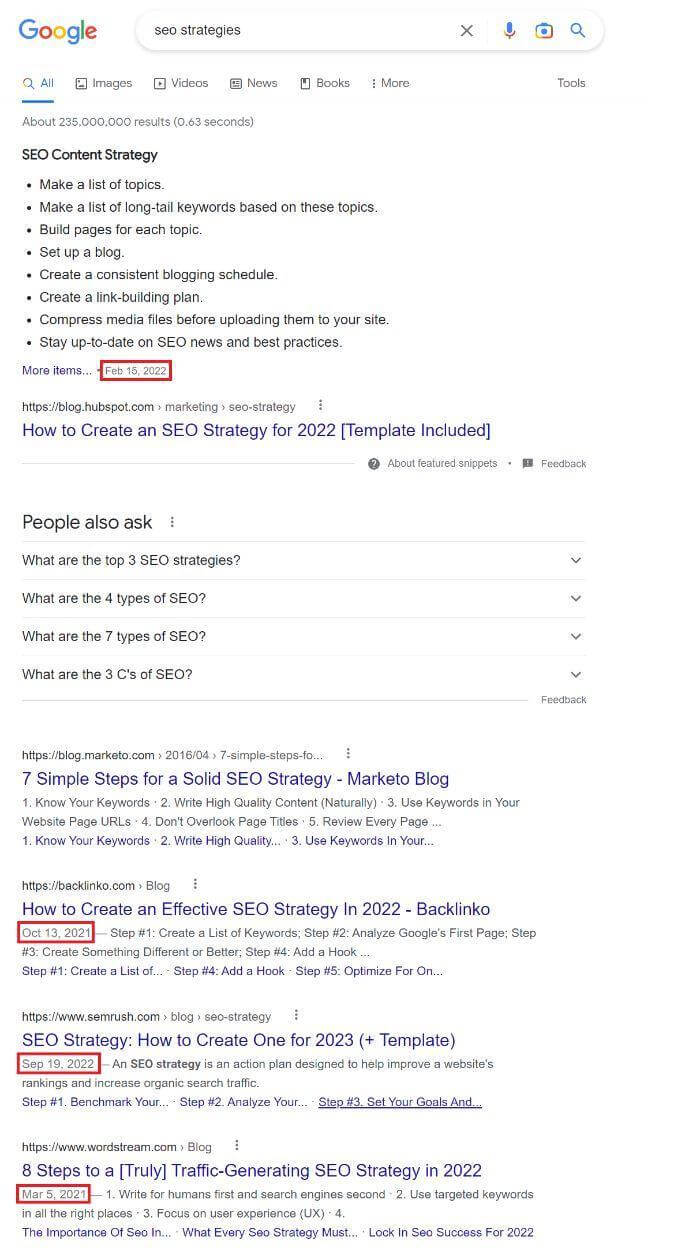
You’ll notice that the oldest of them has a date of April 2016, but the rest of the results have dates ranging from March 5, 2021 through September 19, 2022.
NOTE: The Marketo blog article published in 2016 does not have the publish/update date as part of the structured data HTML markup. However, the majority of the results on the search listing page do contain the markup with more current dates.
The truth is that for a lot of topics, including SEO, times change quickly. Information that was accurate just a few months ago might be completely different now.
This isn’t just with a topic like SEO, however. Imagine searching for “best gardening techniques” or “running shoe reviews.”
Wouldn’t you prefer to read something published in the last year, rather than an article from 2010? Of course you would.
The truth is, we’re more likely to click on articles that have been published recently, and this means the click-through rate of an article you publish will increase when you update it.
This is important because, in Google’s algorithm, you’re more likely to rank higher if more people click on your content from the search engine results page.
So, updating your content will make it more appealing, and that appeal will tell Google it’s a better resource that should rank higher.
But it isn’t just the date that increases your click-through rate.
You can also write a compelling headline and description that grabs your reader’s attention and pulls them in. This helps you maintain a strong position in Google’s results.
It’s also important to keep the headline to about eight words or 70 characters, to make sure your visitors can read the whole title in the search results.
Once the reader clicks through to your content, however, you don’t want them to click away immediately. Great search results are based, in part, on how valuable people find your page.
To make this work in your favor, look to grab the attention of your readers by telling a story using descriptions, or help the reader see things from your point of view.
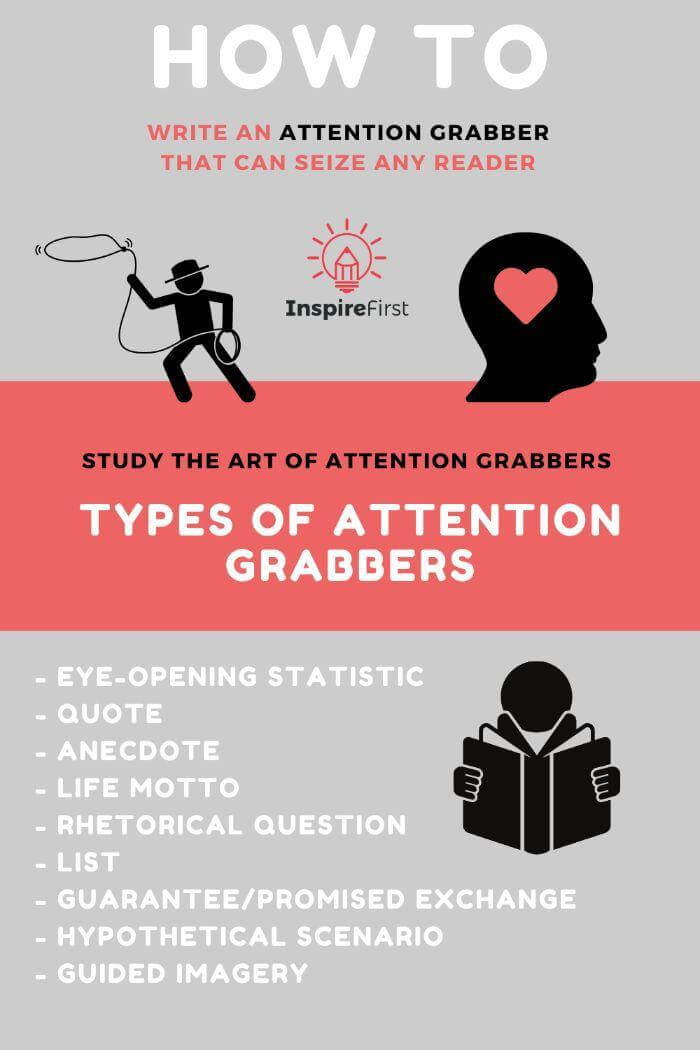
(Source)
By updating your content, you’ll draw more people into your words and get higher search engine rankings as a result.
2. Fix Grammar and Spelling Mistakes
Everyone knows the feeling.
We’re reading an old post we wrote months or even years ago, and we notice a cringeworthy spelling mistake.
Instead of just ignoring it and hoping for the best, spend a bit of time correcting the errors.
Google’s former anti-spam team leader, Matt Cutts, stated that spelling and grammar aren’t one of Google’s 200 ranking factors, but it’s still something to consider.
Poor grammar and spelling negatively impact the user experience, which will play out in your rankings either directly or indirectly.
When Tim Soulo at Ahrefs decided to make minor changes (including mostly spelling and grammar errors) on an old post, he increased traffic to that page by 486%.

Now, to be fair, he didn’t just edit the spelling and grammar mistakes. He also optimized the post for a more relevant keyword, which I’ll discuss in a minute.

Then he changed the date to display the recent fresh content, and he pushed it onto the blog’s homepage and promoted it like a new article.
(I’ll also cover these strategies later in this article.)
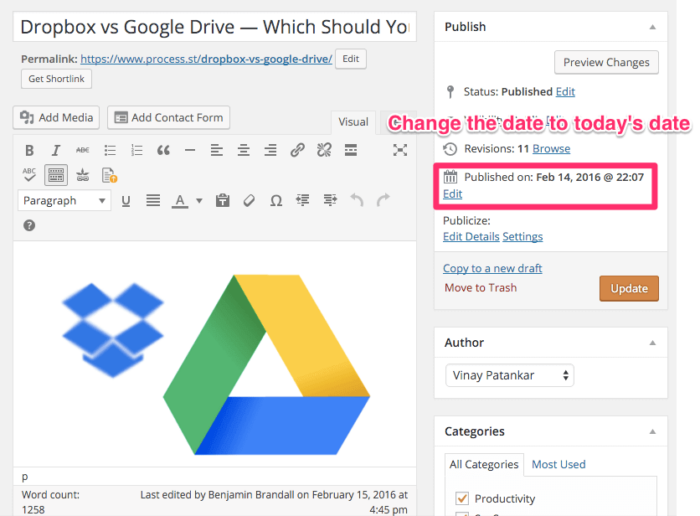
As a result of a change that involved fixing a number of small errors, he was able to drive a massive amount of new traffic to the page.
He also bumped up the search engine placement of the page from #8 to #3.

If you have small errors, it’s time to make some changes and correct your spelling and grammar.
3. Show Google That Your Content is Fresh
It’s no secret that Google loves fresh content.
Content published recently gets a higher ranking, especially for topics that change frequently.
So if you’re only publishing new content, you’re missing out on a huge opportunity. Your old pieces will die a slow death in the search engine rankings.
Instead, you can revive that content. The truth is, updated content is an easy way to double your traffic.
Create a new publication date or just save an update in WordPress. When Google crawls your site again, you’ll see a boost in your search engine traffic.
When Ahrefs launched evergreen content instead of content that was quickly outdated, they saw a massive spike in views and visits. This may be a historical example, but the principle holds through today.

You can do the same thing with your content. Work hard to make sure it’s fresh, and you’ll get the lion’s share of the Google results your articles deserve.
It’s an easy way to improve your rankings by demonstrating you have fresh content.
4. Improve Your Content’s Accuracy
At the end of the day, every Google update is centered around one thing: improving the user experience.
If your site is designed to make for a great user experience, you’ll succeed with Google’s multiple algorithm changes and constant refining of their ranking factors.
You can make your content more usable and helpful for your visitors by updating it to provide new information or updated content.
In this Wordstream article on Google Ads benchmarks, the original article was updated to include up-to-date and accurate data and recommendations:

This provides additional context for the user, makes the piece more accurate, and improves the worth of the article as a whole.
In fact, the article was originally published in 2016, but it contains relevant information as of the date of this publication.
If you aren’t publishing a news site — or you don’t have an audience large enough to deserve a personal response from Google — you can still implement the same strategies.
To do this, you should look to find new and updated information about the article you’re writing and include it.
Mentioning that you’ve included this new content in an update is a great way to indicate that you’ve gone through the article to improve the content.
And as you create a more valuable resource, look to see your rankings skyrocket.
5. Improve the Freshness of Your Entire Site
It’s a fact: fresh sites rank better.
All things being equal, Google will place a higher priority on sites that update their content frequently.
This is one of the reasons why abandoned sites don’t rank well after a few years, even for articles that would otherwise be very helpful.
If Google recognizes that your site isn’t being updated recently, it will hurt the rankings of all the pages on your site.
To change this, you should skyrocket your traffic by bringing this old content back to life. A few updates on key articles can demonstrate to Google that your entire site is valid.
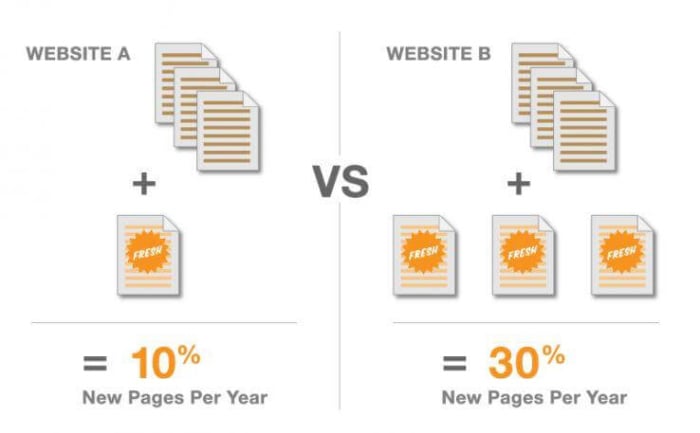
This means that every piece on your site will get a ranking boost as Google recognizes that you have fresh content on your site.
Whether correct or not, Google will interpret this as giving all the articles on your site a higher value, and it will improve the rankings for everything you’ve ever published.
6. Show Value by Removing Broken Links
One of the most frustrating parts of old content is finding broken links.
Oftentimes, the helpful resources you linked to in the original article aren’t around anymore. Perhaps the website has been shut down, or the URL has changed.
Either way, it hurts your rankings on Google and it pushes you further down the search engine results page.
Thankfully, fixing your broken links isn’t very difficult.
To do this, I recommend two different free tools. The first is the online site Broken Link Checker.
Go there and type in your domain URL. Then click “Find broken links.”
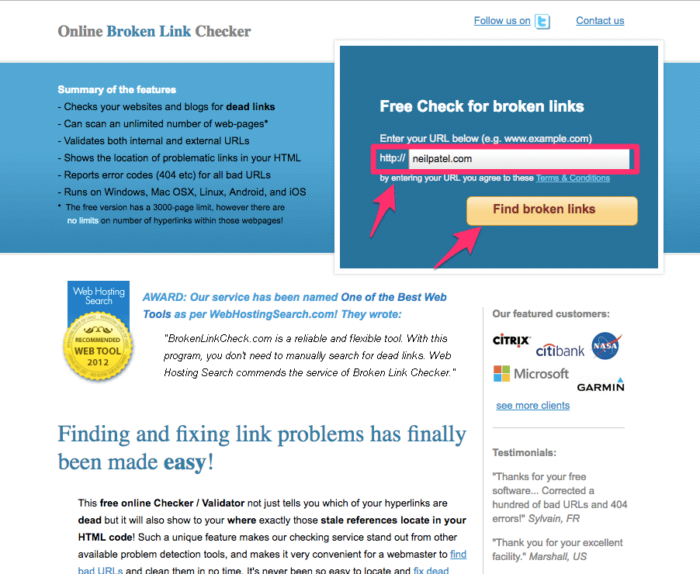
Enter the security code when prompted and click the “Find broken links now!” button.
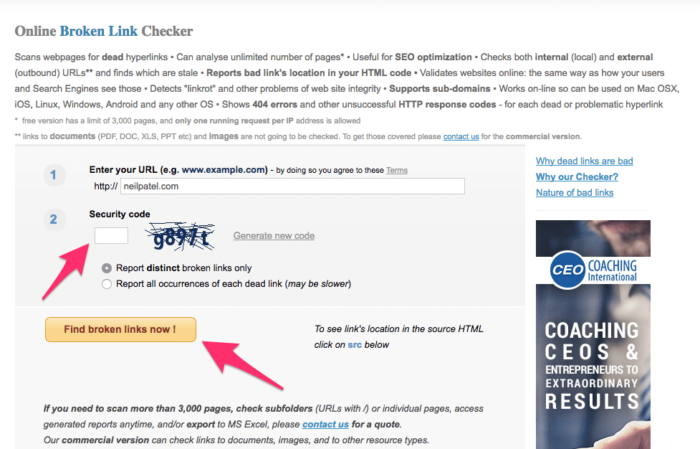
After a few minutes, you’ll get a notification of any links the search found. You should go in and repair these.
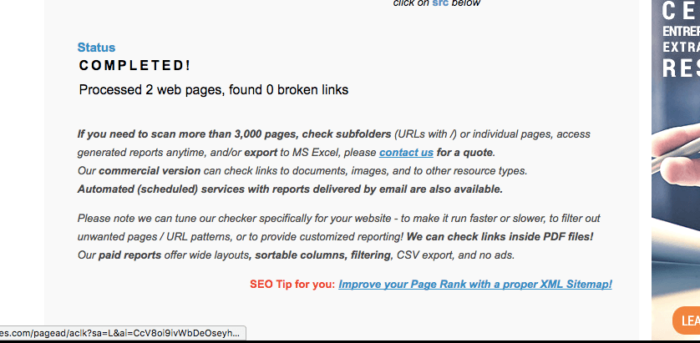
The second tool I recommend is Broken Link Checker for Google Chrome. It’s a free plugin that lives in your Chrome browser.
To start, you’ll need to download it into Chrome by clicking the “+ Add to Chrome” button on the plugin page.
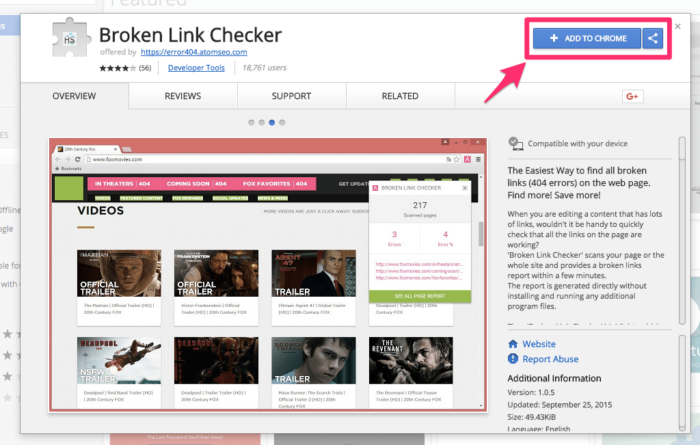
When prompted by Chrome, choose “Add extension.”

It will create a small icon featured in your browser’s header bar.

To use the tool, just navigate to the post you’d like to check and click on the icon. It will display a small box on top of the page.
This will browse all the links on the page and find any that are broken. It will give you a total number of links, both functioning and broken.
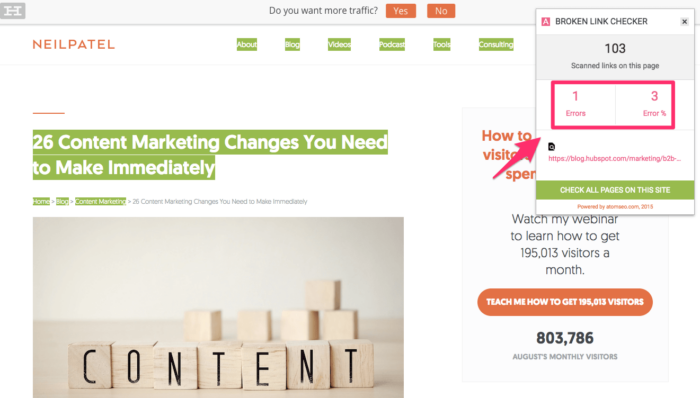
All the links that work properly will be highlighted in green. Any that are missing or lead to 404 pages will show up as pink, along with the problem in finding the link.
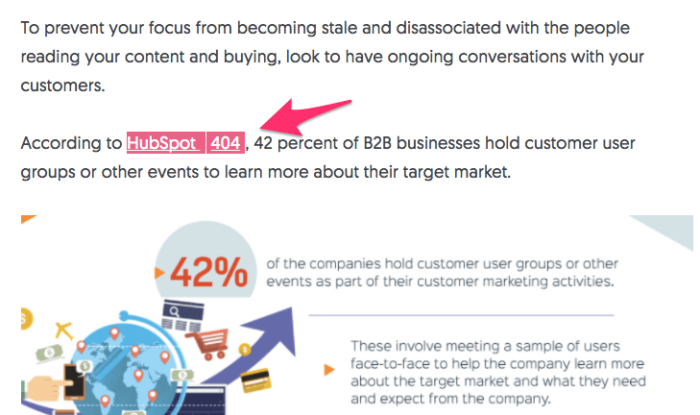
To repair a broken link, you’ll need to find the original page you linked to and look for other ways it might be published. This is the easiest way to improve things.
If the article is truly off the web, you’ll need to take more drastic measures. Look to find another resource that matches the other in quality, and link to that instead.
If you can’t find it at all, and there’s nothing similar, you can just delete the link altogether. It’s better to have no link than a dead one.
Either way, fixing or removing your broken links makes the page more valuable in Google’s eyes and helps to increase your rankings.
7. Link to Newer, Better Resources
If you’re improving your old content, you can also add new links to better resources.
According to HubSpot, research for your content includes using experts, statistics, infographics, events, and breaking news.
As you go back over old content, you can easily add links to this new content. Since these resources weren’t available when you first wrote the piece, it adds a lot of new value.
It also makes your content look much more valuable to Google. Since outbound links are an important ranking factor, you can create a more valuable resource this way.
Link to the best content on the web and Google will take notice. Instead of only linking to those resources, your page will become the go-to hub of information for others.
There’s one last thing you should do with your content: link to your own resources.
If you’ve published a recent article on a related topic, you should link to this.
It’s also a good idea to update the call to action that you currently use and make sure it’s relevant to the new content you’ve updated.
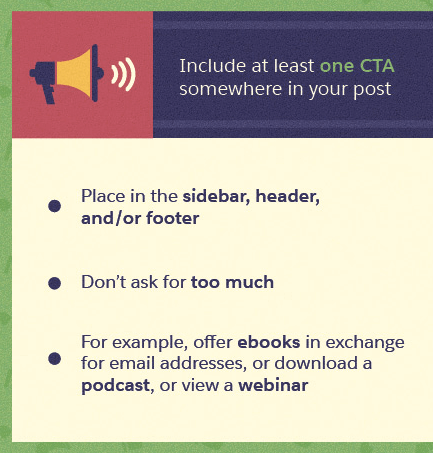
By including up-to-date resources and more in-depth content, you can bring blog posts back to life and drive massive rankings in Google.
It’s the perfect way to increase your search engine traffic without spending hours creating new content or writing lengthy updates to your old posts.
8. Include Multimedia for Better Rankings
One of the best ways to improve your search engine rankings is by adding different types of media.
As the content online becomes more diverse, there is special privilege placed on new content that includes different types of images, plus audio and video.
The use of strong imagery has many benefits, as outlined in the image below:
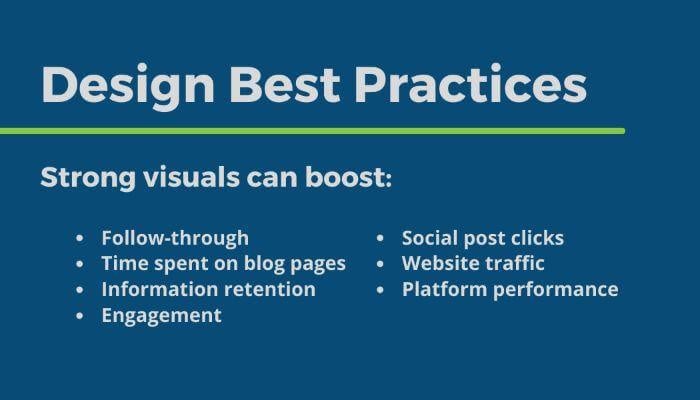
(Source)
The exact types you want to use depends on your preference.
It’s a good idea to include an image for every 150 to 350 words or so.
No matter what images you want to use, you need to include a link back to the original content. This makes it easier for others to know where the image came from.
It also lets you review the images and easily find updated pieces if you need to later.
If you struggle to create interesting images yourself, you can easily find them online by searching sites like StumbleUpon for graphics that are proven to grab attention.

This is a simple way to make your content more appealing without lots of extra work.
This focus on new types of media will make your content more engaging and give you improvements on Google’s search engine results pages.
9. Improve How Often Google Indexes Your Site
As you work to improve the old content you’ve published on your website, you’ll actually start to see benefits across the entire set of content, not just on the articles you’ve updated.
The reason for this is that Google looks at your entire site to see your most recent updates.
This is then used as a measure of how often Google will set aside time to crawl your site.
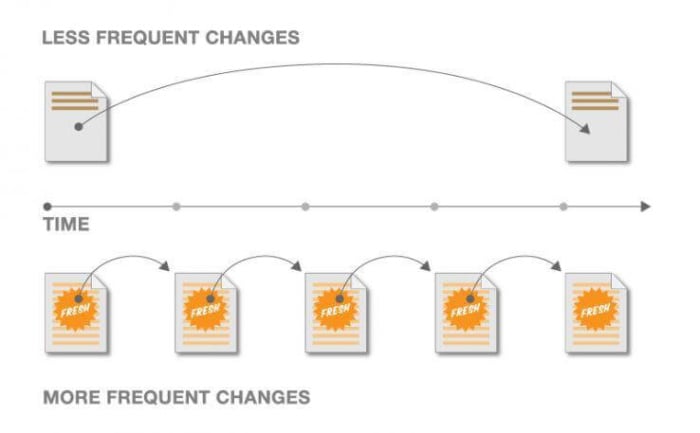
A simple example is the frequency with which Google crawls a news site like the Huffington Post versus a static site, like a simple three-page “about us” website for a local law firm.
With HuffPo publishing articles every hour, Google will learn this frequency and update more often.
Meanwhile, the law firm will get updated every few weeks (or less), since Google recognizes there isn’t new content each time it crawls the site.
By updating old content, you can get Google to crawl your site more frequently without needing to publish more often.
The more Google crawls your site, the more likely your most recent information will show up in search results after publishing, which gives you an advantage in your search engine results rankings.
10. Optimize for the Right Keywords
There’s a chance you didn’t do enough keyword research when you published your original post, or perhaps you didn’t do it the correct way. The keywords you initially targeted could have changed its intent – meaning a once commercial keyword could now be transactional.
Either way, you may find that the old content you published is actually ranking better in keywords you didn’t expect.
Instead of just leaving the keyword focus the same and hoping for the best, you can take proactive steps to improve the keyword focus of the pieces you’ve created.
Here’s how to do that.
First, you’ll want to go to Ubersuggest. Then, follow these steps:
Step #1: Enter your URL and click “search.”

Step #2: Click keyword research > keywords by traffic in the left sidebar.
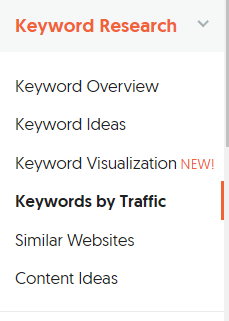
Step #3: Enter your domain or URL in this new window.

Step #4: Review the results.

Once you have the results, you have access to five key pieces of data:
- The keywords your site ranks for
- The estimated monthly search volume of each keyword
- Your website’s current Google ranking (position) for the keyword
- The estimated monthly traffic your website gets for the keyword
- The estimated competition in organic search
With this information, you can decide how to best update your old content to rank higher.
For example, this page of my website currently ranks #3 for the keyword phrase “blogging.”

There are two sites above mine, all of which receive more monthly traffic for this keyword phrase.
By updating this piece of content to better target the primary keyword, I improve the likelihood of reaching the #1 spot. And if that happens, I’ll receive, on average, another 80,000 visitors per month.
11. Share Your Content and Promote It Again
Now that you’ve updated your old post, it’s time to promote it like it’s brand new.
Social media networks drive 0.8% to 12.2% of a website’s traffic, so don’t miss out on this key opportunity.
To begin, make sure you have plenty of share buttons on the page. This ensures that if the article is popular with your audience, you’ll be able to expand its reach.
Without sharing buttons, you can kill all the potential your post has for going viral. Don’t allow that to happen.
Once you’ve fixed this, distribute your content through the normal ways you’d promote a new piece of content.
This might be through sharing it with your email list and posting it on social media. I also recommend contacting influencers about the post you’ve written.
This is a great way to get backlinks from new posts that have just been recently published.
These recent linking pages show Google that the page itself is also fresh since fresh links indicate fresh content.
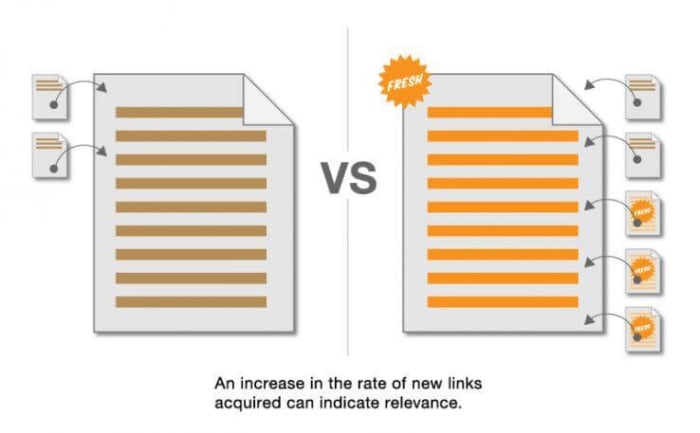
An easy way to guarantee more backlinks is by using ego-bait.
This is a strategy where you reference someone else who looms large in your industry and let them know you quoted them.
Since they’re proud to be featured (hence the term “ego-bait”), they’re more likely to share.
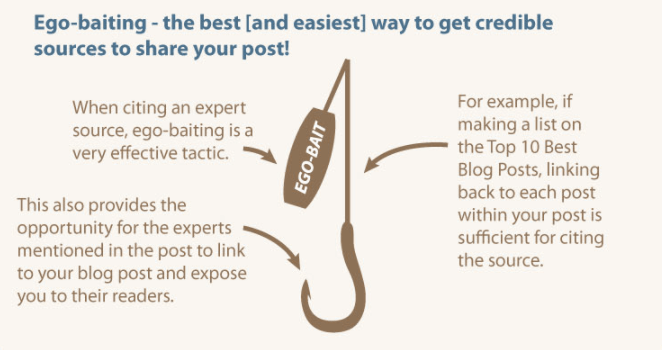
Because this is a strategy you can easily implement with old articles, simply by referencing and linking to new influencers, you can build up a solid backlink profile.
Share your content again, and watch your rankings skyrocket.
12. Fix Any Issues with Recent Google Updates
There are as many as 600 Google updates each year, with each one focusing on improving the algorithm and changing the ranking factors for a number of different sites.
With each new algorithm update, there is a change in how different factors play out for the success in your Google rankings.
To improve your content’s guaranteed success in the Google results, you should work to ensure that all your old content follows the best practices for Google’s latest changes.
Look to see what those changes have been, and add features that give your content the best chance for success.
Take, for example, Google’s new experience algorithm update.
Google has added an extra “E” to its well-known E-A-T (Expertise, Authoritativeness, and Trustworthiness). It’s now E-E-A-T for Experience, Expertise, Authoritativeness, and Trustworthiness.
What does this mean?
Experience in this case stands for a website owner’s or blogger’s experience in the field they claim expertise in. This means you should update your content to include references to your own personal experiences within your field.
Do you need an example of how to do so? Look no further than this article!
Neil Patel Digital is a full-service digital marketing agency. The “data” sections of this piece, and others on our blog, outline our real-world experience as a digital marketing agency. This gives readers that extra confidence they need and enhance our expertise, authoritativeness, and trustworthiness.
Content refreshes that take such updates into account will give you the best shot at maintaining content and staying up to date through the variety of changes Google makes to its algorithm each day.
13. Repurpose Your Content for More Backlinks
To get the most impact from the old article you update, you should create different content types from the original work you did.
Instead of going back and finding new information, just repurpose the research you’ve already done.
There are plenty of ways to repurpose old content, and I recommend doing whatever you feel most comfortable with.
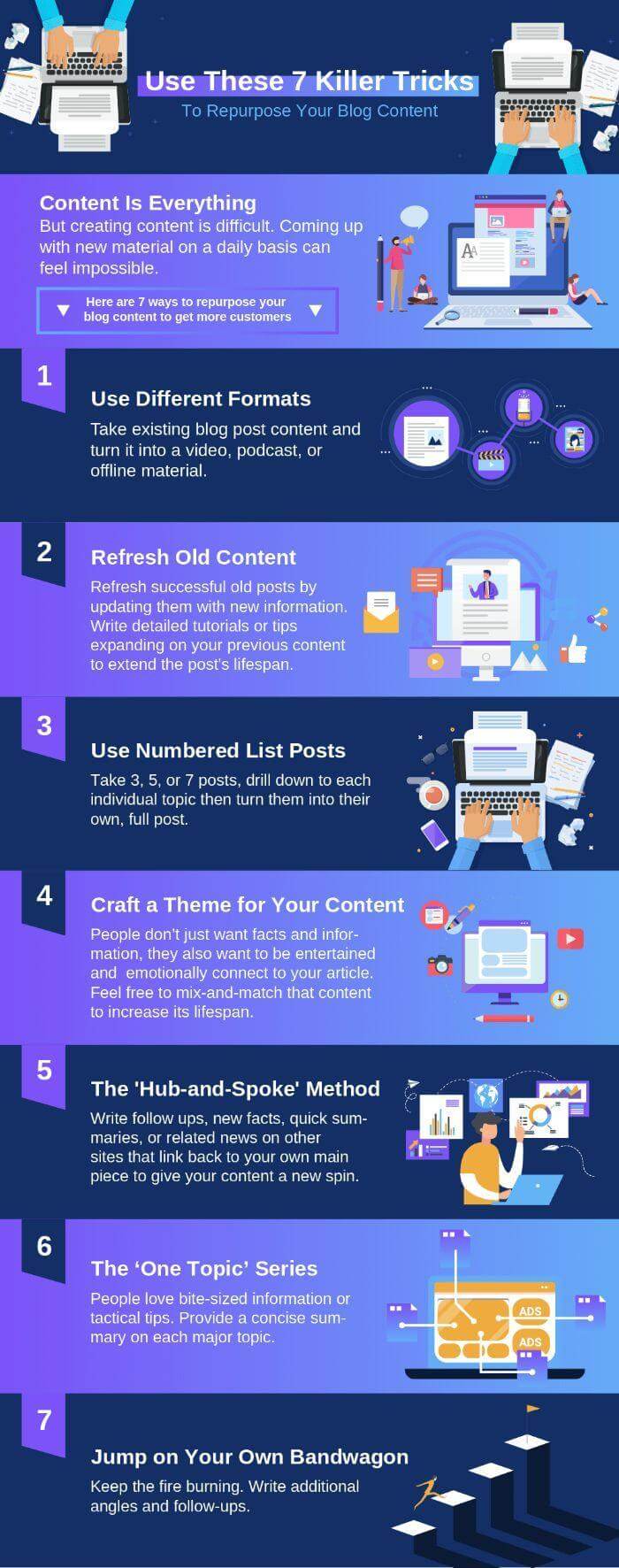
(Source)
By simply reading your old content out loud and recording it, you can create a podcast episode, SoundCloud content, bonus audio for subscribers, or even a content upgrade.
Best of all, this doesn’t require any fancy or expensive equipment. Just record using the built-in microphone on your computer.
Another easy way to create new content from an old post is to craft a SlideShare presentation. Just divide up the post into a few different pieces of information.
The easiest way to do this is to create a separate slide from each piece of content in your article, like breaking the article into subpoints.
Publish your slideshow on SlideShare and promote it again.
These are easy ways to increase the visibility of your post. And when others link to your other content, you can gain new backlinks to what you’re publishing.
As one of the biggest ranking factors for Google and other search engines, backlinks are guaranteed to improve your rankings.
14. Leverage the Value of Your Old Content
Think for a minute about how much of your content is old versus how much is new.
Chances are, 90% or more of your total content is more than a few months old. And every minute, it’s losing value as it becomes less fresh.
The solution is to inject new value into your old content. Those old posts already have value as solid resources. You’ve done the research and created something that’s worthwhile.
Chances are, you’ve even started to develop a lot of backlinks to the content.
So why let it go to waste?
Instead, you should look to update the content.
Google looks for quality content first and foremost. This means that even if you have a recent article on your site, if the quality isn’t there, Google will still prefer the high-quality content that was published years ago.
By updating your old content, you can give it a second life and transform it into content that will continue to drive massive search engine traffic.
Don’t let your old work go to waste. With a little freshening up, you can boost your search engine rankings with old content that’s been given a new look and updated relevance.
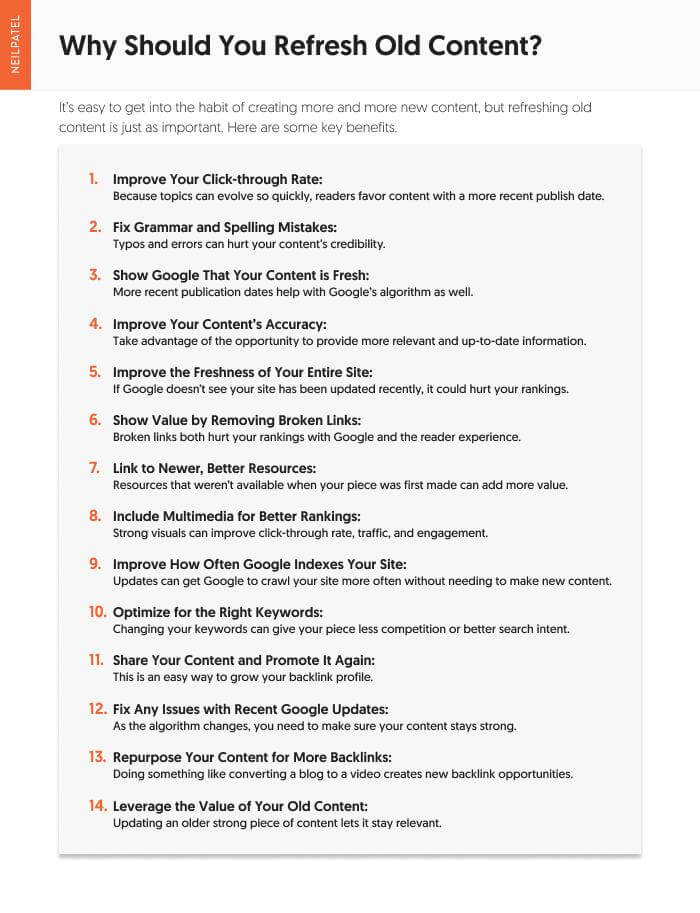
Frequently Asked Questions
Do you have more questions about refreshing your content? Here are the answers to some frequently asked questions on the topic.
How do I choose which pieces of content to refresh?
You should make time to update all of your content at least once per year. If you must prioritize, though, then focus on articles that 1) help you with further developing your content strategy; 2) compete with other articles on your website; and 3) content that saw a significant drop off in performance.
How often should I do content refreshes?
How often you refresh your content will depend on how much content you have. I’d recommend you try to update each blog post at least once per year. If you have too much content to go over in one year, though, then focus on small updates like fixing broken links and removing any dated language.
Conclusion
If you want to boost your SEO, look no further than updating your old content. This is one of many often overlooked content marketing strategies.
This is the perfect way to increase the traffic your website gets from search engines, and it’s guaranteed to make a huge improvement in how well your content ranks.
To start, create compelling new content to add on top of your old articles. Include new resources, clean up any broken links on your site, and include multimedia.
You should also work to improve the accuracy of your content and make sure it’s up to date with the most recent and critical information.
Once you’ve freshened up the content, look to make sure it meets all the newest requirements of Google’s algorithm updates.
Expand the reach of your article by repurposing it to different types of media, and even consider changing the keywords for which it’s optimized.
After you’ve updated the content, it’s time to share it again. Look to promote it in the same way you did earlier, showing the new value to readers and fans alike.
With this complete set of updates for your old content, you’re set to create a powerhouse of search engine improvement for all the older pieces you had forgotten about.
How will you update your old content to help with your rankings?

See How My Agency Can Drive More Traffic to Your Website
- SEO - unlock more SEO traffic. See real results.
- Content Marketing - our team creates epic content that will get shared, get links, and attract traffic.
- Paid Media - effective paid strategies with clear ROI.

Unlock Thousands of Keywords with Ubersuggest
Ready to Outrank Your Competitors?
- Find long-tail keywords with High ROI
- Find 1000s of keywords instantly
- Turn searches into visits and conversions
Free keyword research tool
